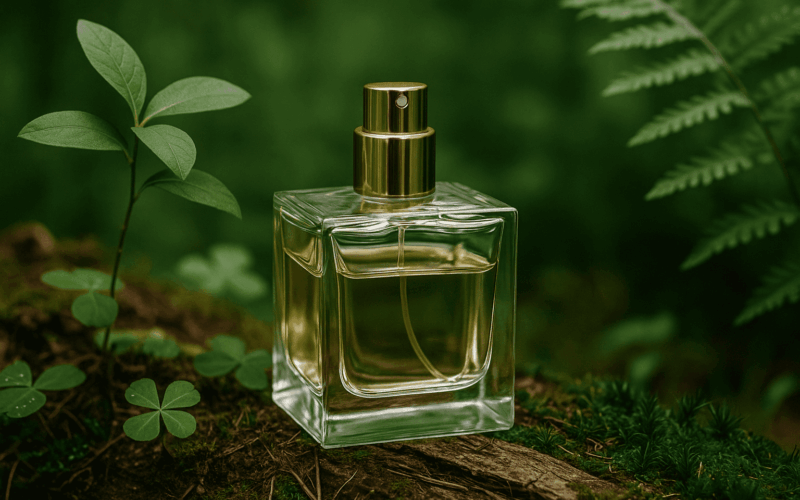A drop of fragrance disappears into the air in seconds, but its journey begins thousands of kilometers before reaching the bottle: at a jasmine plantation, in a laboratory, or on a glassworks floor. More and more fragrance lovers are asking not only about the notes, but also about the footprint their favorite brand leaves on the planet. A concept called “green fragrance culture” has emerged—a practice where the quality of a scent is inseparable from ethical sourcing, energy use, and packaging fate.
Sustainability is no longer a trend. For small manufacturers, it’s a way to express values. For industry giants, it’s a matter of staying relevant with a new generation of buyers. Below are six themed sections that show how the industry is changing from within—and why these changes matter.
The path of an ingredient: sustainable sourcing as foundation
What goes into a bottle isn’t just elegance—it’s a tangible material. A natural rose absolute requires herbicide-free soil, clean water, and a fairly paid farmer. In Africa, shea cooperatives and jasmine-growing communities in India are building certified organic plantations: the soil is rested, flowers are hand-picked before dawn, and only fully opened buds are selected. This reduces yield but protects ecosystems and ensures full traceability.
Yet modern perfumery can’t survive without synthetics. The demand for sandalwood is so high that the tree is now endangered. Lab-made alternatives created through green chemistry mimic the structure of santalol without deforestation. These processes use water-based catalysts and consume up to 60% less energy than traditional reactors.
Traceability is key. Since 2023, several niche brands have adopted blockchain systems: each batch of vanilla is recorded in a smart contract that tracks GPS coordinates, harvest dates, and shipping routes. Buyers can scan a QR code on the box to see how much a farmer was paid per kilo. This level of detail builds trust and encourages others to adopt transparent models.
From bottle to cap: eco-friendly packaging
Glass is often seen as the sustainable alternative to plastic, but its carbon footprint depends on melting temperatures. The Verescence plant in Europe switched to biomethane-fueled furnaces, cutting CO₂ emissions by 70%. They also increased recycled glass content to 45% while maintaining the optical clarity required by luxury brands. The higher the cullet percentage, the less energy needed—since recycled glass melts at lower heat.
Caps and sprayers are tiny details that complicate recycling. Some brands now use mono-material spray heads with no metal springs: a precision polymer acts as the elastic component. This means the whole bottle can be thrown in glass recycling without disassembly. Others go further: offering refill modules where an inner glass insert is removed from the decorative housing and refilled in-store.
Let’s not forget outer boxes. FSC certification ensures cardboard comes from responsibly managed forests. Soy-based inks, no lamination, and avoiding foil embossing reduce toxicity—making packaging easier to recycle. The result: less landfill waste and saved resources.
Green chemistry and zero-waste production
Traditional fragrance reactions used organic solvents like toluene, which left behind toxic residues. Modern labs are turning to enzymatic catalysis: yeast cultures convert monoterpenes into fragrant aldehydes at body temperature. The process happens in water, and the byproduct—biomass—is used as animal feed.
Water is equally critical. Givaudan’s French factory uses a “zero liquid discharge” system. All process water goes through reverse osmosis and ultrafiltration, then gets reused. The company estimates this saves 50 million liters annually and eases the burden on the Rhône River ecosystem.
Waste reduction includes solids too. Orange peel pulp left from essential oil extraction is turned into biogas, which powers steam generators. At glassworks, scrap shards are sent to nearby architectural glass lines, eliminating industrial leftovers.
Brand responsibility: transparency and certification
“Paraben-free” marketing no longer impresses. Consumers want proof. The ISO 16128 standard sets a baseline: ingredients must be not only natural but also sourced in ways that protect biodiversity. Brands also seek Ecocert Cosmos or Cradle to Cradle labels, which assess product life cycles—from raw materials to disposal.
Transparency means more than paperwork. Some manufacturers publish annual energy-use maps: how many kilowatt-hours were used for distillation and what share came from green sources. This helps auditors and customers understand real progress. Life Cycle Assessment tools show that switching to renewable energy can reduce a perfume’s carbon footprint by 25% without changing its formula.
Inclusivity in sustainability also matters. Sana Jardin works on a “flower recycling” model: after extracting orange blossom oil, the spent petals go to Moroccan women’s co-ops to make scented candles. Profits return to the community, closing the economic loop.
Ethical consumption: the buyer’s role
Mindfulness doesn’t end at the store shelf. Consumers choose whether to support fast fragrance or invest in long-wearing scents. Reducing your carbon footprint can be simple:
- buy less but better—one all-season fragrance over three seasonal ones
- opt for refillable bottles and in-store refill services
- check for certifications and published sustainability reports
These actions reduce demand for disposable glass and push brands to adopt greener technologies. If you’re curious about how creative teams design and test new formulas before they’re bottled sustainably, check out our article “Behind the bottle: how niche fragrances are made”
Questions and answers
These labels are audited annually by independent inspectors. They evaluate ingredient origins, energy use, and fair labor practices.
No. You can recycle glass bottles and drop metal parts at a sorting center. Some third-party upcycle programs also accept all packaging.
Yes, if they’re refillable. But single-use plastic samples often increase waste, so choose refillable samples or digital scent subscriptions.

